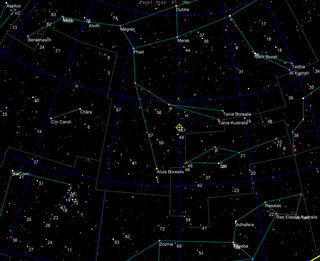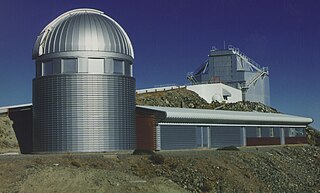Related Research Articles

Michel Gustave Édouard Mayor is a Swiss astrophysicist and professor emeritus at the University of Geneva's Department of Astronomy. He formally retired in 2007, but remains active as a researcher at the Observatory of Geneva. He is co-laureate of the 2019 Nobel Prize in Physics along with Jim Peebles and Didier Queloz, and the winner of the 2010 Viktor Ambartsumian International Prize and the 2015 Kyoto Prize.
Mu Arae, often designated HD 160691, officially named Cervantessur-VAN-teez, is a main sequence G-type star approximately 50 light-years away from the Sun in the constellation of Ara. The star has a planetary system with four known extrasolar planets, three of them with masses comparable with that of Jupiter. Mu Arae c, the innermost, was the first hot Neptune or super-Earth discovered.

47 Ursae Majoris, formally named Chalawan, is a yellow dwarf star approximately 45.3 light-years from Earth in the constellation of Ursa Major. As of 2011, three extrasolar planets are believed to orbit the star.
HD 130322 is a star with a close orbiting exoplanet in the constellation of Virgo. The distance to this system is 104 light years, as determined using parallax measurements. It is drifting closer to the Sun with a radial velocity of −12.4 km/s. With an apparent visual magnitude of 8.04, it is too dim to be visible to the naked eye; requiring binoculars or a small telescope to view. Being almost exactly on the celestial equator the star is visible everywhere in the world except for the North Pole. The star shows a high proper motion, traversing the celestial sphere at an angular rate of 0.197 arcsec yr−1.

Doppler spectroscopy is an indirect method for finding extrasolar planets and brown dwarfs from radial-velocity measurements via observation of Doppler shifts in the spectrum of the planet's parent star. As of November 2022, about 19.5% of known extrasolar planets have been discovered using Doppler spectroscopy.
HD 164922 b is an exoplanet orbiting the star HD 164922 about 72 light-years from Earth in the constellation Hercules. Its inclination is not known, and its true mass may be significantly greater than the radial velocity lower limit of 0.36 Jupiter masses. The planet also has a low eccentricity, unlike most other long period extrasolar planets – 0.05 – about the same as Jupiter and Saturn in the Solar System. The exoplanet was found by using the radial velocity method, from radial-velocity measurements via observation of Doppler shifts in the spectrum of the planet's parent star.

Epsilon Eridani b, also known as AEgir [sic], is an exoplanet approximately 10.5 light-years away orbiting the star Epsilon Eridani, in the constellation of Eridanus. The planet was discovered in 2000, and as of 2023 remains the only confirmed planet in its planetary system. It orbits at around 3.5 AU with a period of around 7.6 years, and has a mass around 0.6 times that of Jupiter. As of 2023, both the Extrasolar Planets Encyclopaedia and the NASA Exoplanet Archive list the planet as 'confirmed'.
HD 8574 is a single star in the equatorial constellation of Pisces. It can be viewed with binoculars or a telescope, but not with the naked eye having a low apparent visual magnitude of +7.12. The distance to this object is 146 light years based on parallax, and it has an absolute magnitude of 3.88. The star is drifting further away from the Sun with a radial velocity of +18 km/s. It has a relatively high proper motion, advancing across the celestial sphere at the rate of 0.298 arc seconds per annum.
HD 118203 b, formally named Staburags, is a jovian planet that takes only 6.13 days or 147 hours to orbit the parent star HD 118203 at a distance of 0.07 astronomical units. The exact mass was not known since inclination was not known until TESS detected the planet. This hot Jupiter is unusual since it has relatively high eccentricity of 0.31.

HD 80606 b is an eccentric hot Jupiter 217 light-years from the Sun in the constellation of Ursa Major. HD 80606 b was discovered orbiting the star HD 80606 in April 2001 by a team led by Michel Mayor and Didier Queloz. With a mass 4 times that of Jupiter, it is a gas giant. Because the planet transits the host star its radius can be determined using the transit method, and was found to be about the same as Jupiter's. Its density is slightly less than Earth's. It has an extremely eccentric orbit like a comet, with its orbit taking it very close to its star and then back out very far away from it every 111 days.

14 Andromedae b, formally named Spe, is an exoplanet approximately 249 light years away in the constellation of Andromeda.
HD 154672 is a yellow subgiant. It is about 65 parsecs away from the Sun that is larger than, but of a similar mass to, the Sun. However, HD 154672 is much older. The star is very metal-rich, which is one of the reasons why it was targeted for a planet search by the N2K Consortium, which discovered the gas giant planet HD 154672 b using Doppler Spectroscopy; the discovery was reported in October 2008. The N2K collaboration chose HD 154672 primarily because it aimed to discover the correlation between a star's metallicity and the mass of orbiting planets.
HD 154672 b is an extrasolar planet located approximately 210 light-years away in the constellation of Ara, orbiting the metal-rich and aged star HD 154672. This planet has a minimum mass five times that of Jupiter and orbits at about 60% the distance between the Earth to the Sun. Its orbit is very elliptical, which causes temperatures on the planet to vary significantly as it proceeds along its orbit. This planet was discovered in Las Campanas Observatory on September 5, 2008 using the radial velocity method. Along with HD 205739 b, the planets were the first to be discovered by the N2K Consortium using the Magellan Telescopes.
HD 205739 b is an extrasolar planet located approximately 350 light-years away.
HD 153950 b, also known as Trimobe, is an extrasolar planet located approximately 162 light-years away. This planet was discovered on October 26, 2008 by Moutou et al. using the HARPS spectrograph on ESO's 3.6 meter telescope installed at La Silla Observatory in Atacama desert, Chile.

Leonhard Euler Telescope, or the Swiss EULER Telescope, is a national, fully automatic 1.2-metre (47 in) reflecting telescope, built and operated by the Geneva Observatory. It is located at an altitude of 2,375 m (7,792 ft) at ESO's La Silla Observatory site in the Chilean Norte Chico region, about 460 kilometers north of Santiago de Chile. The telescope, which saw its first light on 12 April 1998, is named after Swiss mathematician Leonhard Paul Euler.
HD 180902 b is an extrasolar planet orbiting the K-type star HD 180902 approximately 342 light years away in the constellation Sagittarius.

An exoplanet is a planet located outside the Solar System. The first evidence of an exoplanet was noted as early as 1917, but was not recognized as such until 2016; no planet discovery has yet come from that evidence. What turned out to be the first detection of an exoplanet was published among a list of possible candidates in 1988, though not confirmed until 2003. The first confirmed detection came in 1992, with the discovery of terrestrial-mass planets orbiting the pulsar PSR B1257+12. The first confirmation of an exoplanet orbiting a main-sequence star was made in 1995, when a giant planet was found in a four-day orbit around the nearby star 51 Pegasi. Some exoplanets have been imaged directly by telescopes, but the vast majority have been detected through indirect methods, such as the transit method and the radial-velocity method. As of 1 January 2024, there are 5,576 confirmed exoplanets in 4,113 planetary systems, with 887 systems having more than one planet. This is a list of the most notable discoveries.
HD 240237 b is a super-Jupiter exoplanet orbiting the K-type giant star HD 240237 about 4,900 light-years (1,500 parsecs, or nearly 4.6×1016 km) away from Earth in the constellation Cassiopeia. It orbits outside of the habitable zone of its star at a distance of 1.9 AU. The exoplanet was found by using the radial velocity method, from radial-velocity measurements via observation of Doppler shifts in the spectrum of the planet's parent star. The planet has a mildly eccentric orbit.

HD 102956 b or Isagel is an extrasolar planet discovered in 2010 by a team of American astronomers led by John Johnson using Doppler spectroscopy and the Keck Observatory in Hawaii. HD 102956 b is in the orbit of host star HD 102956. The planet is at most the mass of Jupiter, orbiting every 6.5 days at a distance of 12 million km. HD 202956 b has a very circular orbit. The system is roughly 399 light years from us.
References
- 1 2 "Exoplanets: The Hunt Continues!" (Press release). Garching, Germany: European Southern Observatory. April 4, 2001. Retrieved December 27, 2012.
- ↑ "Approved names". NameExoworlds. Retrieved 2020-01-02.
- ↑ "International Astronomical Union | IAU". www.iau.org. Retrieved 2020-01-02.
- 1 2 3 4 5 6 Perrier, C.; et al. (2003). "The ELODIE survey for northern extra-solar planets. I. Six new extra-solar planet candidates". Astronomy and Astrophysics. 410 (3): 1039–1049. arXiv: astro-ph/0308281 . Bibcode:2003A&A...410.1039P. doi:10.1051/0004-6361:20031340. S2CID 6946291.
- 1 2 3 4 Jean Schneider (2003). "Notes on star HD 8574". Extrasolar Planets Encyclopaedia . Archived from the original on July 2, 2007. Retrieved 9 June 2011.
- ↑ "Stellar Magnitudes". Physics and Astronomy Department. University of Tennessee at Knoxville. Retrieved 9 June 2011.
- ↑ "Kepler Discoveries". Ames Research Center . NASA. 2011. Archived from the original on 2010-05-27. Retrieved 9 June 2011.